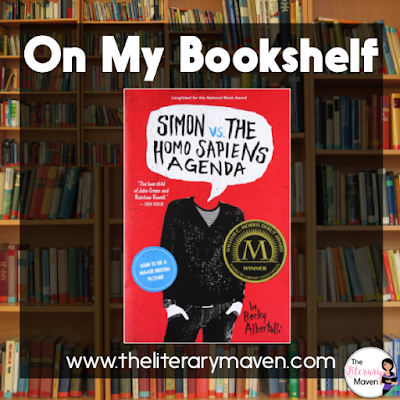The basic plot from Amazon: Sixteen-year-old and not-so-openly gay Simon Spier prefers to save his drama for the school musical. But when an email falls into the wrong hands, his secret is at risk of being thrust into the spotlight. Now change-averse Simon has to find a way to step out of his comfort zone before he's pushed out—without alienating his friends, compromising himself, or fumbling a shot at happiness with the most confusing, adorable guy he's never met.
Incredibly funny and poignant, this twenty-first-century coming-of-age, coming out story—wrapped in a geek romance—is a knockout of a debut novel by Becky Albertalli.
 Why I liked it: In Simon vs. the Homo Sapiens Agenda, Simon is your typical teenager, trying to figure out where he fits in and decide who he is; he just also happens to be not so openly gay and being blackmailed by a classmate for it.
Why I liked it: In Simon vs. the Homo Sapiens Agenda, Simon is your typical teenager, trying to figure out where he fits in and decide who he is; he just also happens to be not so openly gay and being blackmailed by a classmate for it.
Friendship and relationships are universal themes in the novel. Nick, Leah, and Simon have always been a close trio of friends, but now Simon is also growing close with Abby and Abby and Nick may be developing a not so platonic relationship, which leaves Leah feeling left out. Family relationships are also changing for Simon as his older sister Alice is in her first year of college and his younger sister Nora is developing new interests.
If you are interested in purchasing a copy of Simon vs. the Homo Sapiens Agenda for yourself, you can find it on Amazon here.
Note: The Literary Maven is a participant in the Amazon Services LLC Associates Program, an affiliate advertising program designed to provide a means for sites to earn advertising fees by advertising and linking to amazon.com.
Incredibly funny and poignant, this twenty-first-century coming-of-age, coming out story—wrapped in a geek romance—is a knockout of a debut novel by Becky Albertalli.
 Why I liked it: In Simon vs. the Homo Sapiens Agenda, Simon is your typical teenager, trying to figure out where he fits in and decide who he is; he just also happens to be not so openly gay and being blackmailed by a classmate for it.
Why I liked it: In Simon vs. the Homo Sapiens Agenda, Simon is your typical teenager, trying to figure out where he fits in and decide who he is; he just also happens to be not so openly gay and being blackmailed by a classmate for it.Friendship and relationships are universal themes in the novel. Nick, Leah, and Simon have always been a close trio of friends, but now Simon is also growing close with Abby and Abby and Nick may be developing a not so platonic relationship, which leaves Leah feeling left out. Family relationships are also changing for Simon as his older sister Alice is in her first year of college and his younger sister Nora is developing new interests.
Classroom application: The issues surrounding gossip and the use of social media to harass and bully are ones to which all teens can relate. 13 Reasons Why would be a great novel to pair with this one, especially to compare the effects that these issues can have on teenage girls versus teenage boys. It's also an issue that is constantly popping up in current events unfortunately with far too many young people taking their own lives over online harassment and bullying.
The LGBT themes and characters (the main character and others) will help to diversify your classroom library. Because of the sexual content (some dick jokes, fantasizing, and kissing/petting), though it is mild, I would hesitate to include it in a middle school classroom library.
In a mature classroom, you could discuss the range of attitudes that people have toward gays, from accepting to tolerant to slightly homophobic to completely anti-gay. Another rich topic of discussion could be the difficulties of coming out to family and friends, and examining the reactions of Simon and Bram's parents and friends. Do they react appropriately? Are their reactions understandable? Does this make them good or bad parents or friends? A final interesting discussion topic could be the role of parents in general. Simon's parents are frequently featured in the novel. Do students agree with their rules and expectations of their children? Are they similar to the rules and expectations of students' parents?
The LGBT themes and characters (the main character and others) will help to diversify your classroom library. Because of the sexual content (some dick jokes, fantasizing, and kissing/petting), though it is mild, I would hesitate to include it in a middle school classroom library.
In a mature classroom, you could discuss the range of attitudes that people have toward gays, from accepting to tolerant to slightly homophobic to completely anti-gay. Another rich topic of discussion could be the difficulties of coming out to family and friends, and examining the reactions of Simon and Bram's parents and friends. Do they react appropriately? Are their reactions understandable? Does this make them good or bad parents or friends? A final interesting discussion topic could be the role of parents in general. Simon's parents are frequently featured in the novel. Do students agree with their rules and expectations of their children? Are they similar to the rules and expectations of students' parents?
If you are interested in purchasing a copy of Simon vs. the Homo Sapiens Agenda for yourself, you can find it on Amazon here.

Note: The Literary Maven is a participant in the Amazon Services LLC Associates Program, an affiliate advertising program designed to provide a means for sites to earn advertising fees by advertising and linking to amazon.com.




















